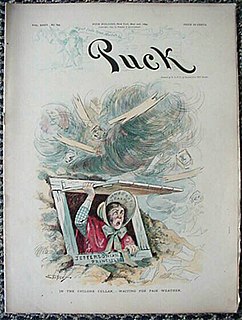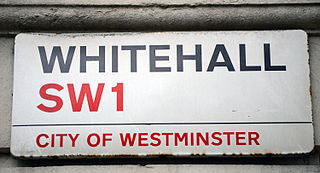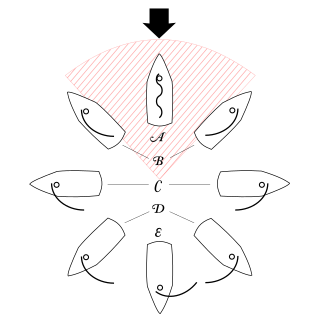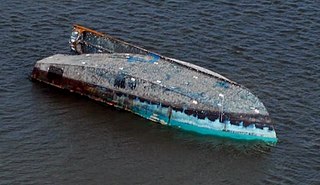Related Research Articles

A metaphor is a figure of speech that, for rhetorical effect, directly refers to one thing by mentioning another. It may provide clarity or identify hidden similarities between two different ideas. Metaphors are often compared with other types of figurative language, such as antithesis, hyperbole, metonymy, and simile. One of the most commonly cited examples of a metaphor in English literature comes from the "All the world's a stage" monologue from As You Like It:

Sailing employs the wind—acting on sails, wingsails or kites—to propel a craft on the surface of the water, on ice (iceboat) or on land over a chosen course, which is often part of a larger plan of navigation.
A simile is a figure of speech that directly compares two things. Similes differ from other metaphors by highlighting the similarities between two things using comparison words such as "like", "as", "so", or "than", while other metaphors create an implicit comparison. This distinction is evident in the etymology of the words: simile derives from the Latin word similis, while metaphor derives from the Greek word metapherein. Like in the case of metaphors, the thing that is being compared is called the tenor, and the thing it is being compared to is called the vehicle.

Word play or wordplay is a literary technique and a form of wit in which words used become the main subject of the work, primarily for the purpose of intended effect or amusement. Examples of word play include puns, phonetic mix-ups such as spoonerisms, obscure words and meanings, clever rhetorical excursions, oddly formed sentences, double entendres, and telling character names.

A figure of speech or rhetorical figure is a word or phrase that intentionally deviates from ordinary language use in order to produce a rhetorical effect. Figures of speech are traditionally classified into schemes, which vary the ordinary sequence of words, and tropes, where words carry a meaning other than what they ordinarily signify.

A synecdoche is a figure of speech in which a term for a part of something refers to the whole of something or vice versa.
Literal and figurative language is a distinction within some fields of language analysis, in particular stylistics, rhetoric, and semantics.

A point of sail is a sailing craft's direction of travel under sail in relation to the true wind direction over the surface.
In literature and writing, stylistically elements are the use of any of a variety of techniques to give an auxiliary meaning, ideas, or feeling to the literalism or written.
This is a glossary of nautical terms; some remain current, while many date from the 17th to 19th centuries. See also Wiktionary's nautical terms, Category:Nautical terms, and Nautical metaphors in English. See the Further reading section for additional words and references.
Semantic change is a form of language change regarding the evolution of word usage—usually to the point that the modern meaning is radically different from the original usage. In diachronic linguistics, semantic change is a change in one of the meanings of a word. Every word has a variety of senses and connotations, which can be added, removed, or altered over time, often to the extent that cognates across space and time have very different meanings. The study of semantic change can be seen as part of etymology, onomasiology, semasiology, and semantics.
Owing to its origin in ancient Greece and Rome, English rhetorical theory frequently employs Greek and Latin words as terms of art. This page explains commonly used rhetorical terms in alphabetical order. The brief definitions here are intended to serve as a quick reference rather than an in-depth discussion. For more information, click the terms.
In continental philosophy —the Real is that which is the intelligible form of the ontological truth-horizon of the field-of-objects-disclosed; the opposite of fantasy, dreams, and hallucinations. The Real is a "negative space", a philosophical void of "sociality" and "subjectivity"—a traumatic consensus of intersubjectivity, an absolute noumenalness between signifiers.

In dinghy sailing, a boat is said to be turtling or to turn turtle when the boat is fully inverted with the mast pointing down to the lake bottom, riverbed, or seabed. The name stems from the appearance of the upside-down boat, similar to the carapace, that is the top shell of a sea turtle. The term can be applied to any vessel; turning turtle is less frequent but more dangerous on ships than on smaller boats. Relative to monohulls, it is more hazardous on multihulls, because of their inherent stability in an inverted position. Measures can be taken to prevent a capsize from becoming a turtle.
A literary trope is the use of figurative language, via word, phrase or an image, for artistic effect such as using a figure of speech. Keith and Lundburg describe a trope as, "a substitution of a word or phrase by a less literal word or phrase." The word trope has also come to be used for describing commonly recurring literary and rhetorical devices, motifs or clichés in creative works. Literary tropes span almost every category of writing, including poetry, television, and art. Tropes can be found in all literature.
Reification is a fallacy of ambiguity, when an abstraction is treated as if it were a concrete real event or physical entity. In other words, it is the error of treating something that is not concrete, such as an idea, as a concrete thing. A common case of reification is the confusion of a model with reality: "the map is not the territory".

An idiom is a common word or phrase with a figurative, non-literal meaning that is understood culturally and differs from what its composite words' denotations would suggest; i.e. the words together have a meaning that is different from the dictionary definitions of the individual words. By another definition, an idiom is a speech form or an expression of a given language that is peculiar to itself grammatically or cannot be understood from the individual meanings of its elements. For example, an English speaker would understand the phrase "kick the bucket" to mean "to die" – and also to actually kick a bucket. Furthermore, they would understand when each meaning is being used in context.

HMS Blossom was an 18-gun Cormorant-class sloop-of-war. She was built in 1806 and is best known for the 1825–1828 expedition under Captain Beechey to the Pacific Ocean. She explored as far north as Point Barrow, Alaska, the furthest point into the Arctic any non-Inuit had been at the time. She was finally broken up in 1848.
Chico Bon Bon: Monkey with a Tool Belt is a children's animated streaming television series based on a series of books of the same name by Chris Monroe. The series is set in Blunderburg and revolves around Chico Bon Bon and his friends Clark the elephant, Rainbow Thunder the daredevil cat and Tiny the mouse trying to solve problems using STEM concepts.
The author J. R. R. Tolkien uses many proverbs in The Lord of the Rings to create a feeling that the world of Middle-earth is both familiar and solid, and to give a sense of the different cultures of the Hobbits, Men, Elves, and Dwarves who populate it. Scholars have also commented that the proverbs are sometimes used directly to portray characters such as Barliman Butterbur, who never has time to collect his thoughts. Often these proverbs serve to make Tolkien's created world seem at once real and solid, while also remaining somewhat unfamiliar. Further, the proverbs help to convey Tolkien's underlying message about providence; while he keeps his Christianity hidden, readers can see that what appears as luck to the protagonists reflects a higher purpose throughout Tolkien's narrative.
References
- ↑ The Oxford Companion to the English Language (1992) pp.653–55: "A rhetorical figure with two senses, both originating with Aristotle in the 4c BC: (I) All figures of speech that achieve their effects through association, comparison and resemblance. Figures like antithesis, hyperbole, metonymy and simile are [in that sense] all species of metaphor. [But] this sense is not current, ..."
- 1 2 3 4 Jeans, Peter D (1998). Ship to Shore. Oxford, England: ABC-Clio. ISBN 1-85109-321-4.
- ↑ Smyth, William Henry; Belcher, Edward (1867). The sailor's word-book: An alphabetical digest of nautical terms, including some more especially military and scientific ... as well as archaisms of early voyagers, etc. London: Blackie and Son. pp. 680, 121.
- ↑ "Regulation 34 - Safe Navigation". IMO RESOLUTION A.893(21) adopted on 25 November 1999. Retrieved March 26, 2007.
- ↑ Honeck, Richard P. (1980) Cognition and figurative language pp.405-417
- Further reading
- Isil, Olivia A. (1966). When a loose cannon flogs a dead horse there's the devil to pay: seafaring words in everyday speech. Camden ME: International Marine. ISBN 978-0-07-032877-8.
- Miller, Charles A. (2003). Ship of state: the nautical metaphors of Thomas Jefferson : with numerous examples by other writers from classical antiquity to the present. Lanham, MD: University Press of America. ISBN 978-0-7618-2516-6.
- Milligan, Christopher S.; Smith, David C. (1997). "Language from the Sea: Discovering the Meaning and Origin of Nautical Metaphors". English Quarterly. 28 (4): 36–40.
- Naval Air Station Jacksonville (1942). "Service Jargon". 9780070328778A-V(S) Indoctrination School. Department of the Navy. Retrieved June 17, 2010.